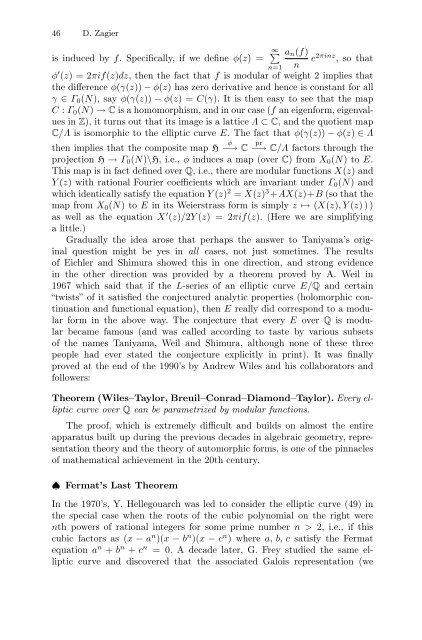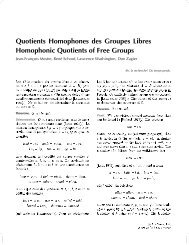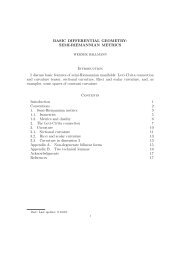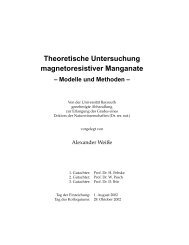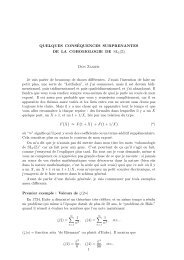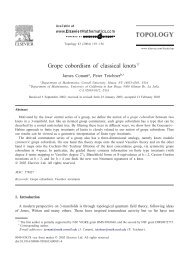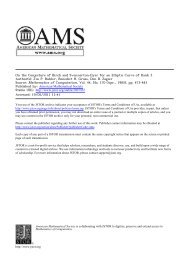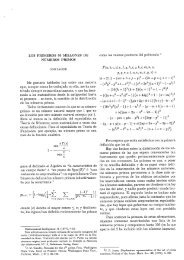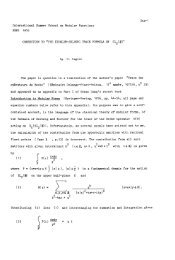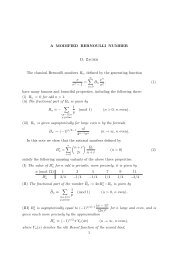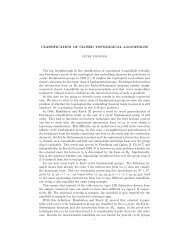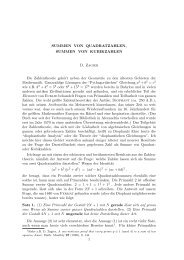Elliptic Modular Forms and Their Applications - Up To
Elliptic Modular Forms and Their Applications - Up To
Elliptic Modular Forms and Their Applications - Up To
Create successful ePaper yourself
Turn your PDF publications into a flip-book with our unique Google optimized e-Paper software.
46 D. Zagiera n (f)is induced by f. Specifically, if we define φ(z) =e 2πinz ,sothatn=1 nφ ′ (z) =2πif(z)dz, then the fact that f is modular of weight 2 implies thatthe difference φ(γ(z)) − φ(z) has zero derivative <strong>and</strong> hence is constant for allγ ∈ Γ 0 (N), sayφ(γ(z)) − φ(z) =C(γ). It is then easy to see that the mapC : Γ 0 (N) → C is a homomorphism, <strong>and</strong> in our case (f an eigenform, eigenvaluesin Z), it turns out that its image is a lattice Λ ⊂ C, <strong>and</strong> the quotient mapC/Λ is isomorphic to the elliptic curve E. Thefactthatφ(γ(z)) − φ(z) ∈ Λthen implies that the composite map H −→ φC −→ prC/Λ factors through theprojection H → Γ 0 (N)\H, i.e., φ induces a map (over C) fromX 0 (N) to E.ThismapisinfactdefinedoverQ, i.e., there are modular functions X(z) <strong>and</strong>Y (z) with rational Fourier coefficients which are invariant under Γ 0 (N) <strong>and</strong>which identically satisfy the equation Y (z) 2 = X(z) 3 +AX(z)+B (so that themap from X 0 (N) to E in its Weierstrass form is simply z ↦→ (X(z),Y(z) ))as well as the equation X ′ (z)/2Y (z) = 2πif(z). (Here we are simplifyinga little.)Gradually the idea arose that perhaps the answer to Taniyama’s originalquestion might be yes in all cases, not just sometimes. The resultsof Eichler <strong>and</strong> Shimura showed this in one direction, <strong>and</strong> strong evidencein the other direction was provided by a theorem proved by A. Weil in1967 which said that if the L-series of an elliptic curve E/Q <strong>and</strong> certain“twists” of it satisfied the conjectured analytic properties (holomorphic continuation<strong>and</strong> functional equation), then E really did correspond to a modularform in the above way. The conjecture that every E over Q is modularbecame famous (<strong>and</strong> was called according to taste by various subsetsof the names Taniyama, Weil <strong>and</strong> Shimura, although none of these threepeople had ever stated the conjecture explicitly in print). It was finallyproved at the end of the 1990’s by Andrew Wiles <strong>and</strong> his collaborators <strong>and</strong>followers:Theorem (Wiles–Taylor, Breuil–Conrad–Diamond–Taylor). Every ellipticcurve over Q can be parametrized by modular functions.The proof, which is extremely difficult <strong>and</strong> builds on almost the entireapparatus built up during the previous decades in algebraic geometry, representationtheory <strong>and</strong> the theory of automorphic forms, is one of the pinnaclesof mathematical achievement in the 20th century.♠ Fermat’s Last TheoremIn the 1970’s, Y. Hellegouarch was led to consider the elliptic curve (49) inthe special case when the roots of the cubic polynomial on the right werenth powers of rational integers for some prime number n>2, i.e., if thiscubic factors as (x − a n )(x − b n )(x − c n ) where a, b, c satisfy the Fermatequation a n + b n + c n = 0. A decade later, G. Frey studied the same ellipticcurve <strong>and</strong> discovered that the associated Galois representation (we∞ ∑


